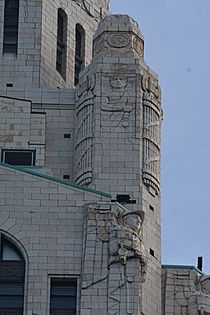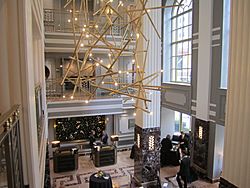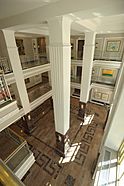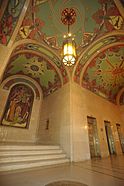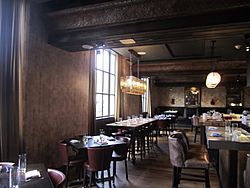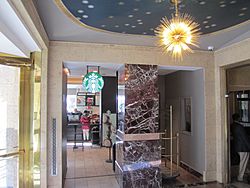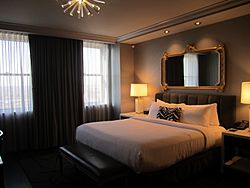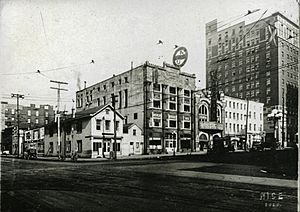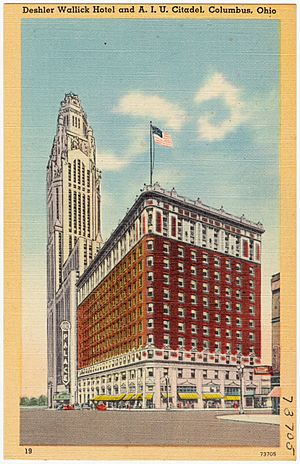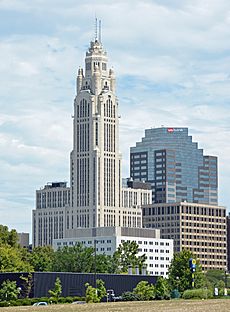LeVeque Tower facts for kids
Quick facts for kids LeVeque Tower |
|
|---|---|
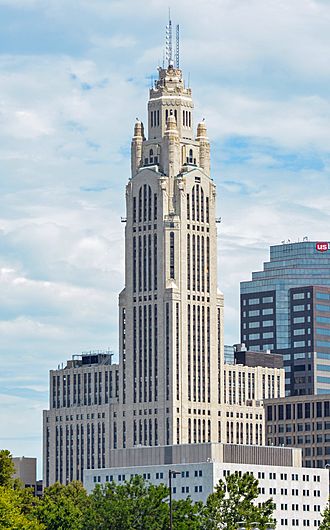 |
|
| Former names | American Insurance Union Citadel |
| Record height | |
| Tallest in Columbus from 1927 to 1974 | |
| Preceded by | Capitol Trust Building |
| Surpassed by | Rhodes State Office Tower |
| General information | |
| Type | Mixed-use |
| Architectural style | Art Moderne |
| Address | 50 W. Broad St., Columbus, Ohio |
| Groundbreaking | September 23, 1924 |
| Completed | September 21, 1927 |
| Cost | $7.8 million |
| Height | 555 ft 5 in (169.29 m) |
| Dimensions | |
| Other dimensions | 188 ft (57 m) east-west and north-south |
| Technical details | |
| Floor count | 47 |
| Design and construction | |
| Architect | C. Howard Crane |
|
American Insurance Union Citadel
|
|
| Area | 353,768 square feet (32,866.1 m2) |
| NRHP reference No. | 75001398 |
| Significant dates | |
| Added to NRHP | March 21, 1975 |
The LeVeque Tower is a huge 47-story skyscraper in Downtown Columbus, Ohio. It stands 555 feet 5 inches (169.29 m) tall. From 1927 to 1974, it was the tallest building in Columbus. Today, it is still the second-tallest building in the city.
This amazing building was designed by C. Howard Crane. It opened in 1927 as the American Insurance Union Citadel. At that time, it was the fifth tallest building in the whole world! The tower cost about $8.7 million to build. It has beautiful decorations and a special outer layer made of terracotta. The original design included 600 hotel rooms and a theater called the Palace Theatre.
After its first owner faced financial troubles, the tower was renamed the Lincoln-LeVeque Tower in 1946. It became the LeVeque Tower in 1977. Over the years, the tower changed owners several times. In 2011, new investors bought it. They turned it into a mixed-use development. This means it now has a hotel, apartments, offices, and a restaurant. This big renovation finished in 2017.
Contents
Building the LeVeque Tower
What we now call the LeVeque Tower was first ordered by the American Insurance Union. This group started in 1894. It was an insurance company, a secret society, and a social club. John J. Lentz, who later became a U.S. Representative, led the group.
The tower was first named the "American Insurance Union Citadel." It was meant to be the main office for the group. It replaced a smaller building in downtown Columbus, near the Scioto River. The tower was designed by C. Howard Crane, an architect from Detroit, Michigan. He was known for his grand and impressive designs.
Design and Features

The original plan for the tower had three main parts. There was a 47-story tower with lots of office space. On each side of the tower, there were two 18-story wings. It also included the 2,827-seat Keith-Albee Theater, which is now the Palace Theatre. Plus, there were 600 hotel rooms for the Deshler-Wallick Hotel. The building was planned to be 188 feet (57 m) wide and 555 feet 5 inches (169.29 m) tall. This height was chosen to be 5 inches (130 mm) taller than the Washington Monument!
The building was designed in the art moderne style. It took ideas from Byzantine architecture, which is an old style of building from the 4th to 13th centuries. The architect first thought about using stone. But he chose cream-colored terracotta instead. This material covers the outside of the building.
The tower has many figures on its facade, high up on the building. These include eagles with huge 22 feet (6.7 m) wingspans. There are also giants and angels up to 26 feet (7.9 m) tall. Some of these were later taken down. This happened because people worried about pieces falling. Also, it gave better views from the top floors.
At the very top, there is an octagonal tower with narrow windows. It is topped by a dome with special heraldic designs. Inside, the building has marble from Italy and Belgium. Public areas are decorated with bronze and mosaics. The lobby floor has a bronze plaque. It shows the building's horoscope and the positions of the planets when it was started.
When it was finished, the building was lit up at night. Its four turrets were lit with bright floodlights. This made it a landmark for pilots. Sometimes, it could be seen from up to 20 miles (32 km) away! The top of the tower was even designed for zeppelins to moor, or dock. Later, it held radio antennae.
Building Process
The elevators in the building were very modern for their time. They were controlled by push buttons and could travel 900 feet (270 m) per minute. They went up to the 41st floor. A special shuttle elevator then took people to the observation deck. Water tanks for fire safety and plumbing were on the 23rd and 43rd floors. The building also had backup mechanical systems.
On the 43rd floor, there was an executive dining room called the Mid-Air Club. The 44th floor was an observation deck open to the public for 25 cents. It had 24 large windows. There was also a balcony on the 46th floor, but you needed a ladder to reach it!
About 60 construction companies worked on the tower. The total cost was $7.8 million. The terracotta for the outside came from Chicago. Two older buildings were torn down to make space for the new tower.
At the busiest time, about 650 men worked on the building. Work began on September 23, 1924. Workers dug deep foundations, 114 feet (35 m) into the bedrock. They used air pressure to dig through 80 feet (24 m) of water. Special workers called "sandhogs" were brought in. They had experience building the Holland Tunnel in New York City. The construction site even had a hospital and a special room for workers who got sick from working underground.
Sadly, on January 26, 1925, four workers died in an accident underground. A toxic gas was released. A fifth worker died later after falling from the steel frame. The building's first stone was laid on February 13, 1926. The frame used 10,000 tonnes (9,800 long tons; 11,000 short tons) of steel. The building had 100 miles (160 km) of electrical wire, 137,000 feet (42,000 m) of heating pipe, 67 electric motors, 14,000 electrical outlets, and 1,756 windows.
Construction took 19 months. The building was officially opened on September 21, 1927. When it was finished, it was the tallest building in Columbus. It was also the fifth tallest building in the world. It was the tallest building between New York City and Chicago!
The word "Citadel" has a special meaning. It shows how important this building is for a great organization that helps people. In old times, cities like Nuremberg and Quebec had strong walls to protect them. Inside those walls, there was often a "Citadel," like a strong castle. This was a second line of defense. The name Citadel is perfect for a big insurance company. Millions of families in the United States protect themselves from danger through this kind of organization. —Albert Bushnell Hart, speaking at the building's opening, September 21, 1927.
Art and architecture experts really liked the tower's design. Dudley Crafts Watson, from the Chicago Art Institute, called it "the most original and American of skyscrapers." He said it was "just an honest piece of magnificent construction." Another writer, Edna Clarke, said it was "a milestone in the growth of the city." She felt it showed Columbus changing from a large town into a big city. The tower quickly became a symbol of Columbus. It was the first landmark easily seen from all over the city.
The building was built when Columbus was rebuilding its riverfront. This followed a big flood in 1913. In the 1920s and 1930s, new buildings like the Columbus City Hall and a new federal building were built nearby. The city's population grew a lot, tripling to 375,000 people by 1950.
Lighting Up the Tower
Floodlights were first put on the LeVeque Tower in 1989. They lit up the top floors with white light at night. Later, colored filters were added to change the light colors.
During the building's big renovation from 2012 to 2017, the old floodlights were replaced. New computer-controlled LED lights were installed. These new lights save energy and can create 256 million different color combinations!
The building is now lit up for special events about six to eight times a year. For example, it's pink for breast cancer awareness. It shows rainbow colors for Columbus Pride weekend. It's red, white, and blue for the Fourth of July. It turns purple for Purple Heart recognition. It's teal for ovarian cancer awareness. And it's red and green during the Christmas and holiday season.
- Inside the LeVeque Tower
History of the Tower
Changing Owners and Uses
After the tower was finished, the American Insurance Union used floors 19 and 20. The rest of the space was rented out to other businesses. However, building the tower cost more than expected. The American Insurance Union had to use its savings to pay for it. Also, not all the office space was rented quickly.
The tower quickly became important for radio broadcasting in Columbus. In the late 1920s, radio was becoming very popular. The tower was tall enough for broadcasting. There were no mountains nearby to block radio signals. So, the tower became home to several radio stations, including WAIU. The owner of the American Insurance Union, John J. Lentz, bought WAIU in 1925. He used it to share his ideas. Moving to the tower allowed WAIU to broadcast with more power. By the 1960s, WCOL also had a broadcast room at the top of the tower.
The American Insurance Union faced problems during the Great Depression. It went out of business in 1934. During this time, some people jokingly called the tower the "IOU Tower" because of the financial troubles. After the company went bankrupt, the building was sold to pay off insurance policies.
In 1945, Leslie LeVeque and John Lincoln bought the tower. It was renamed the LeVeque-Lincoln Tower. Leslie LeVeque was a local real estate investor. After he passed away, his son Fred LeVeque and his wife, Katherine LeVeque, became important people in Columbus.
New Buildings and Competition
The LeVeque Tower stood out in the Columbus skyline for a long time. No other tall buildings were built until the 1960s. It was the only building in Columbus taller than 300 feet (91 m) until 1962.
As big companies like Huntington Bank grew in Columbus, new tall buildings were constructed. The LeVeque Tower remained the tallest building in Columbus until the Rhodes State Office Tower was finished in 1974. In 1975, the Lincoln-LeVeque Tower was added to the National Register of Historic Places.
Fred LeVeque bought the Palace Theatre. But he died in a plane crash in 1975. His wife, Katherine LeVeque, then became the head of their real estate company. Even though downtown Columbus had many empty offices, the LeVeque Tower usually had more tenants than other buildings.
Katherine LeVeque took full control of the building in 1977. That year, its name officially changed to the LeVeque Tower. In the 1980s, more new office buildings were built downtown. The LeVeque Tower faced more competition. Katherine LeVeque spent $18 million to update the tower. This included new heating and cooling systems, energy upgrades, and new bathrooms. These changes helped the historic tower compete with newer buildings.
The State of Ohio was a major tenant in the building for many years. The Ohio Department of Job and Family Services rented almost 20 percent of the building until 2003. The Ohio Department of Aging also rented a lot of space. Many law firms and financial services companies also had offices there.
When these big state organizations moved out, it hurt the building's finances. In 2004, a new company took over the tower. It was worth $22 million then. The building was about one-third empty. Katherine LeVeque had thought about turning part of the building into homes. But it was too expensive at the time.
In 2005, the building was sold again for $8.5 million. It was still about one-third empty. The new owner promised to make big improvements. These renovations helped attract some smaller businesses. But even with new leasing teams, the office space was still about one-third empty by 2009.
Big Renovation in 2012
In 2011, a group of Columbus real estate investors bought the tower for $4 million. At this point, 43 percent of the office space was empty. The new owners planned a $22 million project. They wanted to fix the cracked terracotta on the outside. They also wanted to change the building from just offices into a hotel and homes.
In 2012, the owners announced the renovation would cost $26.7 million. This included $5 million in tax credits from the State of Ohio. The renovation was completed in 2017. It involved a lot of work to fix the terracotta and make the inside modern.
The LeVeque Tower was redesigned as a mixed use development. Floors 5 to 10 became a 150-room boutique hotel called Hotel LeVeque. It is part of Marriott International's Autograph Collection. It also has event spaces. Floors 3, 4, and 11-18 were updated for office space. The top 19 floors were turned into fancy homes. These included 68 apartments and 12 condominiums. There are two special penthouse units on the very top floors. A restaurant called The Keep opened on the second floor.
Other Parts of the LeVeque Tower
Deshler Hotel
The two wings of the LeVeque Tower were used for 600 extra rooms for the Deshler Hotel. This hotel was built nearby in 1916. It already had 400 rooms and was meant to be a luxury hotel.
When the LeVeque Tower opened, the hotel was called the Deshler-Wallick Hotel. The 600 new rooms in the tower were connected to the hotel by a "venetian bridge" on the second floor. Many important people stayed at the hotel. President Harry S. Truman stayed there in 1946 and 1953.
In 1964, the hotel was sold and renamed the Deshler-Cole. The new owner removed the 600 hotel rooms from the LeVeque Tower. He spent $2 million to remodel the main hotel. The "venetian bridge" was then torn down. The hotel was sold one last time in 1966 and closed in 1968. It was torn down in 1969. Today, the One Columbus Center building stands on that spot.
Palace Theatre
The Palace Theatre, at 34 W. Broad St., opened on November 8, 1926. It was a vaudeville house, meaning it showed live stage shows. Many famous performers appeared there before they became huge stars. These included Bing Crosby, George Burns, Gracie Allen, Jack Benny, and Mae West. Mae West's show in March 1938 broke all attendance records!
In the 1940s, many famous bands played there. These included Duke Ellington, Tommy Dorsey, Glenn Miller, and Louis Armstrong. The theater also hosted the world premiere of the play The Male Animal in 1942. Famous actors like Henry Fonda and Olivia de Havilland attended.
The theater closed in 1975. People thought it might be torn down for a parking lot. But in 1980, Katherine LeVeque used her own money to renovate and restore it. It then started hosting new acts. Performers like Red Skelton, Sammy Davis, Jr., and Tony Bennett appeared there.
Today, the Palace Theatre still operates. It has a main auditorium with 2,827 seats. It was designed for vaudeville shows and movies. The Columbus Association for the Performing Arts took over the theater in 1989.
While the LeVeque Tower was designed by C. Howard Crane, the Palace Theatre inside it was designed by another famous theater architect, Thomas W. Lamb. Lamb was the favorite architect for the Keith Albee theater chain.
Images for kids
See also
 In Spanish: LeVeque Tower para niños
In Spanish: LeVeque Tower para niños


